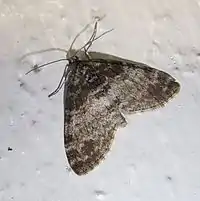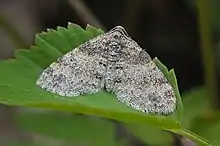Lobophora halterata
Lobophora halterata, the seraphim, is a moth of the family Geometridae. It was first described by Johann Siegfried Hufnagel in 1767. The species can be found in central and northern Europe and a few localities in southern Europe, Siberia, Amur, Primorye, Sakhalin and Japan.

| Lobophora halterata | |
|---|---|
 | |
| Scientific classification | |
| Kingdom: | |
| Phylum: | |
| Class: | |
| Order: | |
| Family: | |
| Genus: | |
| Species: | L. halterata |
| Binomial name | |
| Lobophora halterata (Hufnagel, 1767) | |
The wingspan is 20–25 mm. The length of the forewings is 12–15 mm. Forewing whitish, with a very slight tinge of brown, at least in the central area; a narrow subbasal dark band, closely followed by conspicuous broader one, the pale line which separates them angulated anteriorly; the lines of the median area ill-defined, dentate. Hindwing white, nearly always with a narrow greyer distal border and sometimes with one or two indistinct lines in outer half. Forewing beneath very weakly but more uniformly marked; hindwing with very distinct discal dot. Variable in the intensity of the markings.[1]
Notes
- ^ The flight season refers to the British Isles. This may vary in other parts of the range.
References
- Prout, L. B. 1912–16. Geometridae. In A. Seitz (ed.) The Macrolepidoptera of the World. The Palaearctic Geometridae, 4. 479 pp. Alfred Kernen, Stuttgart.